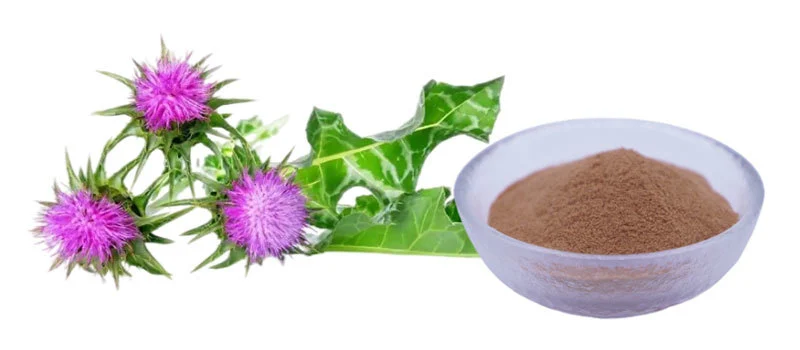Silymarin Powder Composition and Key Active Flavonoids Explained
Silymarin powder, derived from the seeds of the milk thistle plant (Silybum marianum), has gained significant attention in the health and wellness industry due to its potent antioxidant and hepatoprotective properties. This golden-yellow powder is a complex mixture of flavonolignans, with silymarin being the primary active component. Understanding the composition of silymarin powder is crucial for appreciating its therapeutic potential and ensuring product quality. In this comprehensive guide, we'll delve into the key flavonoids present in silymarin powder, explore their biological roles, and examine how the composition influences its liver-protective effects. Additionally, we'll discuss the quality standards and purity considerations essential for manufacturers and consumers alike. By unraveling the intricacies of silymarin powder, we aim to provide valuable insights into this remarkable natural extract and its applications in various industries, from pharmaceuticals to nutraceuticals and cosmetics.

Key Flavonoids in Silymarin Powder and Their Biological Roles
Silybin: The Primary Active Component
Silybin, also known as silibinin, is the most abundant and biologically active flavonolignan in silymarin powder. This compound accounts for approximately 50-70% of the total silymarin content and is primarily responsible for the extract's hepatoprotective effects. Silybin exhibits potent antioxidant properties, scavenging free radicals and protecting liver cells from oxidative stress. Additionally, it has been shown to stabilize cell membranes, promote protein synthesis, and inhibit inflammatory mediators. In silymarin powder, silybin exists as a mixture of two diastereoisomers, silybin A and silybin B, which may have slightly different biological activities. The high concentration of silybin in silymarin powder contributes significantly to its overall therapeutic potential in liver health and beyond.
Silydianin and Silychristin: Supporting Flavonolignans
While silybin is the star player in silymarin powder, other flavonolignans such as silydianin and silychristin play essential supporting roles. Silydianin, which typically comprises 10-20% of the total silymarin content, has been shown to possess antioxidant and anti-inflammatory properties. It may also contribute to the overall hepatoprotective effects of silymarin powder by enhancing liver cell regeneration. Silychristin, another key flavonolignan, accounts for approximately 10-15% of the silymarin complex. This compound has demonstrated antioxidant activities and may help protect against lipid peroxidation in liver cells. The synergistic action of these supporting flavonolignans in silymarin powder enhances its overall therapeutic efficacy, making it a valuable ingredient in various health and wellness applications.
Isosilybin and Other Minor Components
In addition to the major flavonolignans, silymarin powder contains several minor components that contribute to its diverse biological activities. Isosilybin, a diastereoisomer of silybin, is present in smaller quantities but has shown promising antioxidant and anti-cancer properties. Other minor flavonolignans, such as silybinome and 2,3-dehydrosilybin, may also contribute to the overall effects of silymarin powder. Furthermore, the extract contains trace amounts of flavonoids like taxifolin and quercetin, which add to its antioxidant capacity. The presence of these minor components in silymarin powder highlights the importance of using a standardized extract that preserves the natural composition of milk thistle seeds. This complex mixture of bioactive compounds works synergistically to provide a wide range of health benefits, making silymarin powder a versatile and valuable ingredient in various industries.
How the Composition of Silymarin Powder Influences Its Liver-Protective Effects?
Antioxidant Mechanisms and Free Radical Scavenging
The composition of silymarin powder plays a crucial role in its potent liver-protective effects, particularly through its antioxidant mechanisms. The high concentration of flavonolignans, especially silybin, contributes to the extract's ability to neutralize harmful free radicals and reduce oxidative stress in liver cells. Silymarin powder acts as a powerful antioxidant by donating electrons to stabilize reactive oxygen species (ROS) and preventing lipid peroxidation. This antioxidant activity is essential for protecting hepatocytes from damage caused by toxins, alcohol, and other harmful substances. The synergistic action of various flavonolignans in silymarin powder enhances its overall antioxidant capacity, making it more effective than individual components alone. By combating oxidative stress, silymarin powder helps maintain liver cell integrity and function, supporting overall liver health and detoxification processes.
Membrane Stabilization and Protein Synthesis
The unique composition of silymarin powder contributes to its ability to stabilize cell membranes and promote protein synthesis in liver cells. Silybin, the primary active component, has been shown to interact with cell membranes, increasing their stability and reducing the entry of toxins into hepatocytes. This membrane-stabilizing effect is crucial for maintaining liver cell integrity and preventing cellular damage. Additionally, the flavonolignans in silymarin powder stimulate RNA polymerase I activity, leading to increased ribosomal RNA synthesis and enhanced protein production. This boost in protein synthesis supports liver cell regeneration and repair, which is essential for recovering from liver damage. The combined action of membrane stabilization and increased protein synthesis makes silymarin powder an effective agent for supporting liver health and function, particularly in cases of toxin-induced liver injury or chronic liver diseases.
Anti-inflammatory and Fibrosis-Inhibiting Properties
The diverse composition of silymarin powder contributes to its anti-inflammatory and fibrosis-inhibiting properties, which are crucial for liver protection and regeneration. The flavonolignans in silymarin powder, particularly silybin and silychristin, have been shown to modulate inflammatory pathways by inhibiting pro-inflammatory mediators such as NF-κB and TNF-α. This anti-inflammatory action helps reduce liver inflammation and prevent further damage to hepatocytes. Moreover, silymarin powder has demonstrated the ability to inhibit the activation of hepatic stellate cells, which are responsible for collagen production and fibrosis development in the liver. By suppressing fibrogenesis, silymarin powder helps prevent the progression of liver diseases to more severe stages, such as cirrhosis. The combined anti-inflammatory and anti-fibrotic effects of silymarin powder make it a valuable therapeutic agent for various liver conditions, including alcoholic liver disease, non-alcoholic fatty liver disease (NAFLD), and viral hepatitis.
Quality Standards and Purity Considerations for Silymarin Powder
Standardization of Silymarin Content
Ensuring consistent quality and efficacy of silymarin powder requires strict standardization of its active components. Reputable manufacturers, like Avans NutriHealth Co., Ltd., adhere to rigorous quality control measures to standardize the silymarin content in their products. Typically, high-quality silymarin powder is standardized to contain 80% or more of total flavonolignans, with silybin being the predominant compound. This standardization process involves advanced extraction techniques and analytical methods to quantify the active components accurately. High-performance liquid chromatography (HPLC) is commonly used to determine the flavonolignan profile and ensure batch-to-batch consistency. Standardization not only guarantees the potency of silymarin powder but also allows for more precise dosing in various applications, from dietary supplements to pharmaceutical formulations. When selecting a silymarin powder supplier, it's crucial to choose one that provides detailed certificates of analysis (COA) demonstrating the standardized content and purity of their product.
Testing for Contaminants and Adulterants
Maintaining the purity of silymarin powder is paramount for ensuring its safety and efficacy. Quality manufacturers implement comprehensive testing protocols to detect and eliminate potential contaminants and adulterants. This includes screening for heavy metals, pesticide residues, microbial contamination, and mycotoxins. Advanced analytical techniques such as inductively coupled plasma mass spectrometry (ICP-MS) for heavy metal analysis and gas chromatography-mass spectrometry (GC-MS) for pesticide residue detection are employed to ensure the purity of silymarin powder. Additionally, reputable suppliers conduct tests to identify any potential adulterants or substitutes that may be used to mimic the appearance or effects of genuine silymarin. These rigorous testing procedures not only comply with regulatory requirements but also provide assurance to customers about the quality and safety of the silymarin powder. When sourcing silymarin powder, it's essential to partner with manufacturers who prioritize quality control and can provide comprehensive documentation of their testing protocols and results.
Compliance with International Quality Standards
To meet the diverse needs of the global market, high-quality silymarin powder must comply with various international quality standards and regulations. Leading manufacturers ensure their production processes and facilities adhere to Good Manufacturing Practices (GMP) and obtain relevant certifications such as ISO 22000, HACCP, and FSSC 22000. These certifications demonstrate a commitment to quality management systems and food safety standards. For silymarin powder intended for use in dietary supplements, compliance with regulations set by authorities like the U.S. Food and Drug Administration (FDA) and the European Food Safety Authority (EFSA) is crucial. This includes adhering to specific labeling requirements and ensuring that health claims are substantiated by scientific evidence. Furthermore, manufacturers may seek additional certifications such as organic, kosher, or halal to cater to specific market segments. By complying with these international standards, manufacturers of silymarin powder can ensure their product meets the highest quality benchmarks and is suitable for use in various industries worldwide.
Conclusion
Silymarin powder, with its complex composition of flavonolignans, stands as a powerful natural extract with remarkable liver-protective properties. The synergistic action of its key components, primarily silybin, silydianin, and silychristin, contributes to its antioxidant, anti-inflammatory, and regenerative effects on liver cells. As the demand for natural hepatoprotective agents continues to grow, understanding the composition and quality considerations of silymarin powder becomes increasingly important. By prioritizing standardization, purity, and compliance with international standards, manufacturers can ensure the delivery of high-quality silymarin powder that meets the diverse needs of the pharmaceutical, nutraceutical, and cosmetic industries.
At Avans NutriHealth Co., Ltd., we are committed to producing premium silymarin powder that meets the highest quality standards. Our state-of-the-art facilities, rigorous quality control processes, and dedication to innovation ensure that our customers receive superior products for their health and wellness applications. With our extensive experience in plant extract manufacturing and our comprehensive range of certifications, we are well-positioned to meet the growing global demand for high-quality silymarin powder. For more information about our products and services, please contact us at Lillian@avansnutri.com. Choose Avans NutriHealth Co., Ltd. for your silymarin powder needs and experience the difference that quality and expertise can make in your formulations.
FAQ
What is the recommended dosage of silymarin powder for liver health?
The typical dosage ranges from 420-600 mg per day, divided into 2-3 doses. However, it's best to consult with a healthcare professional for personalized advice.
Can silymarin powder be used in combination with other liver support supplements?
Yes, silymarin powder can often be safely combined with other liver support supplements. However, it's important to consult with a healthcare provider before starting any new supplement regimen.
How long does it take to see the benefits of silymarin powder supplementation?
While individual responses may vary, some people report improvements in liver function markers within 4-8 weeks of consistent use.
Is silymarin powder safe for long-term use?
Silymarin powder is generally considered safe for long-term use when taken as directed. However, it's always best to consult with a healthcare professional for personalized advice.
Can silymarin powder be used in topical skincare formulations?
Yes, silymarin powder can be incorporated into skincare products due to its antioxidant properties, which may help protect the skin from oxidative stress and aging.
References
1. Abenavoli, L., Capasso, R., Milic, N., & Capasso, F. (2010). Milk thistle in liver diseases: past, present, future. Phytotherapy Research, 24(10), 1423-1432.
2. Biedermann, D., Vavříková, E., Cvak, L., & Křen, V. (2014). Chemistry of silybin. Natural Product Reports, 31(9), 1138-1157.
3. Saller, R., Melzer, J., Reichling, J., Brignoli, R., & Meier, R. (2007). An updated systematic review of the pharmacology of silymarin. Forschende Komplementärmedizin, 14(2), 70-80.
4. Vargas-Mendoza, N., Madrigal-Santillán, E., Morales-González, A., Esquivel-Soto, J., Esquivel-Chirino, C., García-Luna y González-Rubio, M., ... & Morales-González, J. A. (2014). Hepatoprotective effect of silymarin. World Journal of Hepatology, 6(3), 144-149.
5. Wianowska, D., & Wiśniewski, M. (2015). Simplified procedure of silymarin extraction from Silybum marianum L. Gaertner. Journal of Chromatographic Science, 53(2), 366-372.
6. Ziprin, R. L., & Tsuchiya, H. M. (1984). Oxidative stability of milk thistle seed oil. Journal of Food Science, 49(4), 1157-1159.



